The growth of Mumbai as the commercial capital of one of the largest emerging economies, namely India, has been made possible by high-density urban developments in the form of residential complexes and work campuses. One of these has been developed on a site just shy of 10 hectares on the land of the defunct Nirlon Yarn factory. In the redevelopment scheme designed by us we prioritised the urban spaces between the buildings creating an urban landscape of high quality by retaining old trees and planting many new ones. The primacy of the urban landscape is the backdrop against which the buildings get their ambiance. The belief is that the landscaped spaces between the buildings add value to them.

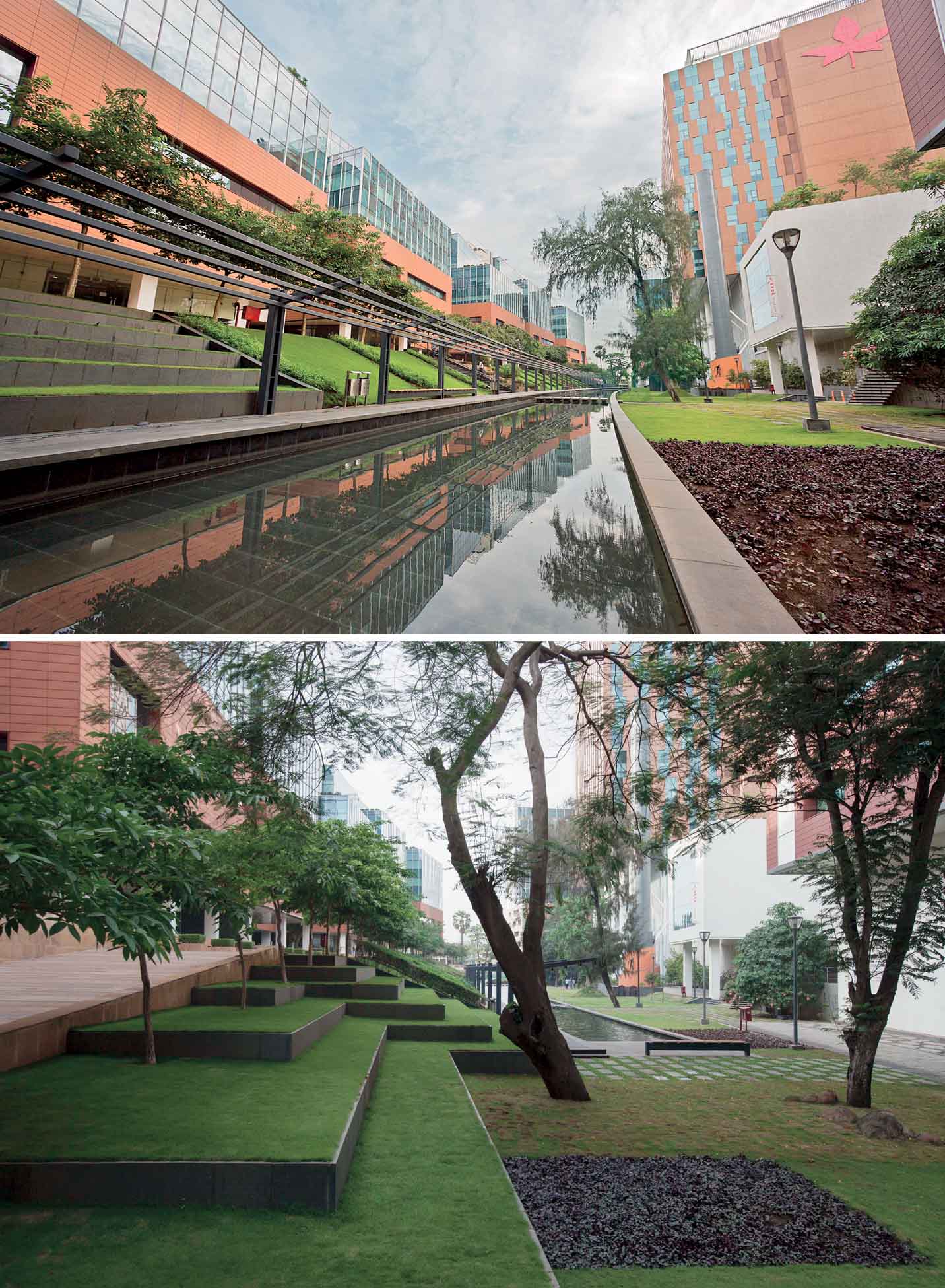
A dilemma of high-density development is not only to create the buildings and work places for its many occupants but also to somehow accommodate the many car parking spaces, which are vital in a high concentration of workspaces.
To give an idea of the magnitude of this, the Nirlon Knowledge Park, which has been designed and built over the last 10 years has place for nearly 35,000 employees. In spite of the fact that many employees use various types of public transportation, a large number of car parking spaces had to be built.
Right from the outset, the design philosophy was to create public spaces as an interlinked set of parks exclusively for the use of pedestrians. There was no space allotted for cars and they had to be tucked away safely elsewhere, preferably under the buildings. However, the ability of the campus, which has been built in five phases, to put away cars in multilayered parking garages beneath the buildings was undermined by the existence of solid rock underground.
In the first four phases of development, a solution was found by building parking garages in large footprints, only partly under the ground and partly above, letting the buildings straddle them and allowing the landscape to climb up the upper layer of the parking garage in the form of a terraced landscape. This helped not only tuck away the parking areas but also created a unique landscape identity with terraces and steps. The level differences thus created afford seating spaces and views of the activity areas.
However, in the fifth and last phase of development the problem was compounded by the fact that not only was the intensity of building higher than the earlier phases but also the rock under the ground was closer to the surface. Blasting the rock in an already high-density campus not being an alternative, it seemed certain that we would have to opt for stack parking above the ground. As the prospect of a massive and stark parking-box loomed, we frantically searched for an alternative to solve the problem without diluting the park-like qualities of the whole campus.
The belief is that the landscaped spaces between the buildings add value to them
Landscaped rock as an identifiable icon
So, we thought, what if we conceptualised the above-ground parking garage as a sort of rocky outcrop with trees and other green landscape, which had burst above the ground. And what if we dimensioned this volume in such a way that we could accommodate a significant number of cars within it.
Armed with this design concept, we proceeded to make the first conceptual sketches for the parking garage. In order to avoid any misunderstanding about our intent, from the very first day we aptly gave it the name The Rock. To offset the extra costs of this form of a parking garage vis-a-vis a simple box-like structure, it was decided to give this structure extra landscape qualities. The first sketches (shown on the facing page) indicated the form of a rock, which stepped back as it rose up, allowing pedestrians the possibility to walk up the landscaped edifice.
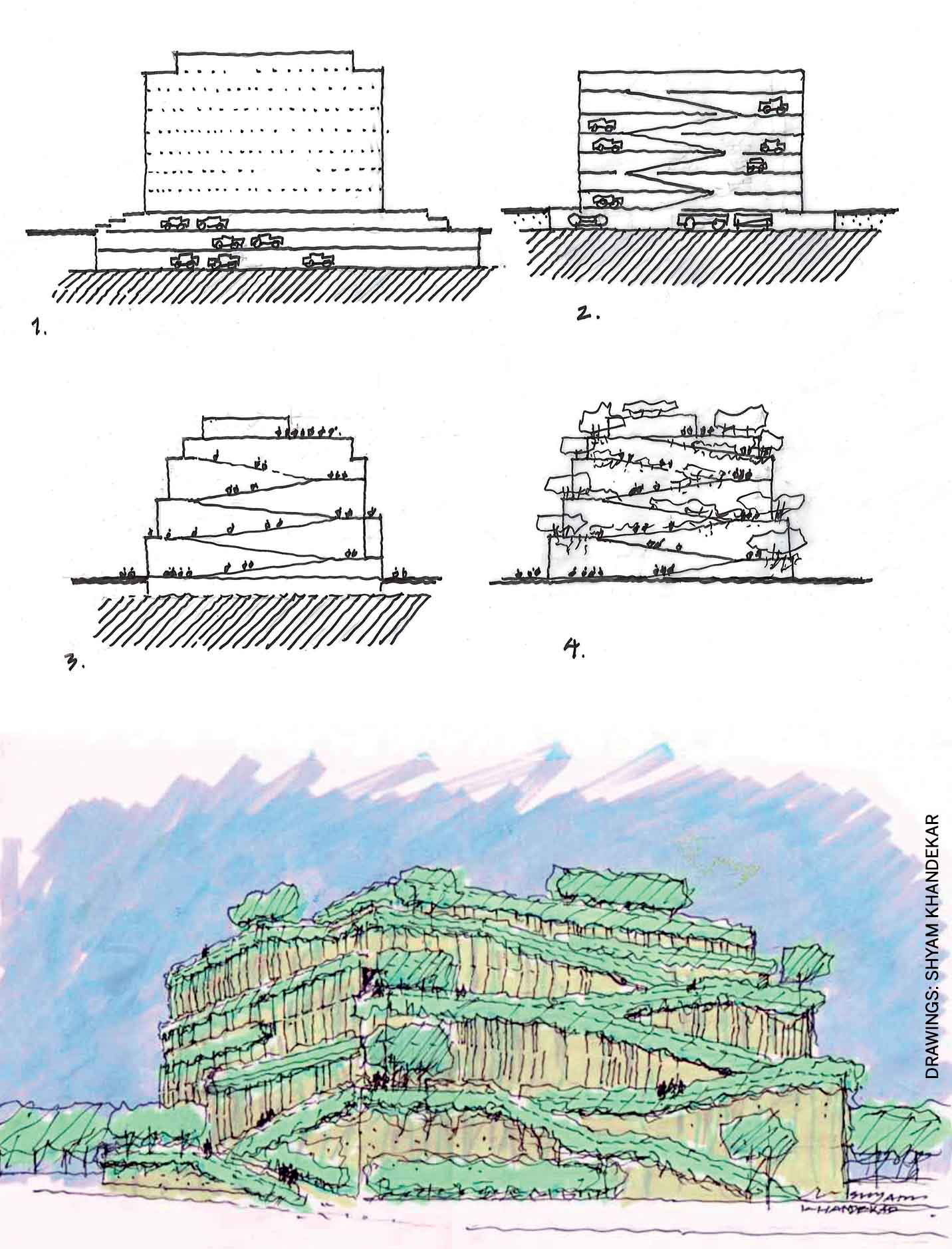
1. Office building with few layers of underground parking
2. Presence of rock closer to surface pushes the parking structure above ground
3. The parking structure is moulded as a climbable rock for pedestrians
4. Landscaping the structure gives it the look of a rocky outcrop
Bottom: Conceptual sketch of The Rock
In the first studies that followed, the possibilities of a landscaped object were simultaneously explored while keeping in mind a reasonable efficiency for the parking garage. This was achieved by conceiving the garage as a series of connected ramps with a driving lane in the middle and parking on both sides of the drive. The pedestrian path, placed outside the core parking area, was conceived as a gently climbing slope that stopped intermittently to create viewing platforms.
Having convinced the client-team of the extra value of this structure, the detailing work began. It was at this stage that an architectural engineering consultancy (VA Architects) and a landscape architect (Lanarch Studio) were brought into the design team. Many months of laborious work followed to detail out an element of landscape, which in fact contains 375 cars on eight floors. At the lowest levels it also accommodates some utilities like an electricity generating plant, water tank, etc.
So, what if we conceptualised the above-ground parking garage as a sort of rocky outcrop with trees and other green landscape
As the design progressed, the path up The Rock was further refined, guided continuously on the outside by broad planters containing bushes and grasses. At strategic moments resting places were introduced for walkers to pause and get a panoramic view of the campus. Pergolas were erected to mark these intermezzos and deep planters introduced at corner locations to plant big trees.
The experience of climbing The Rock is heightened by the creepers, which cover the wire mesh around the main structure. Additionally, for those driving their car into the garage, the wire mesh covered with green creepers creates a surrealistic experience of landscape as viewed from inside the parking garage.
The structure is crowned by a large accommodation on top that can be used as a restaurant or a hall for recreation. The first tenant has decided to use it as a yoga room.
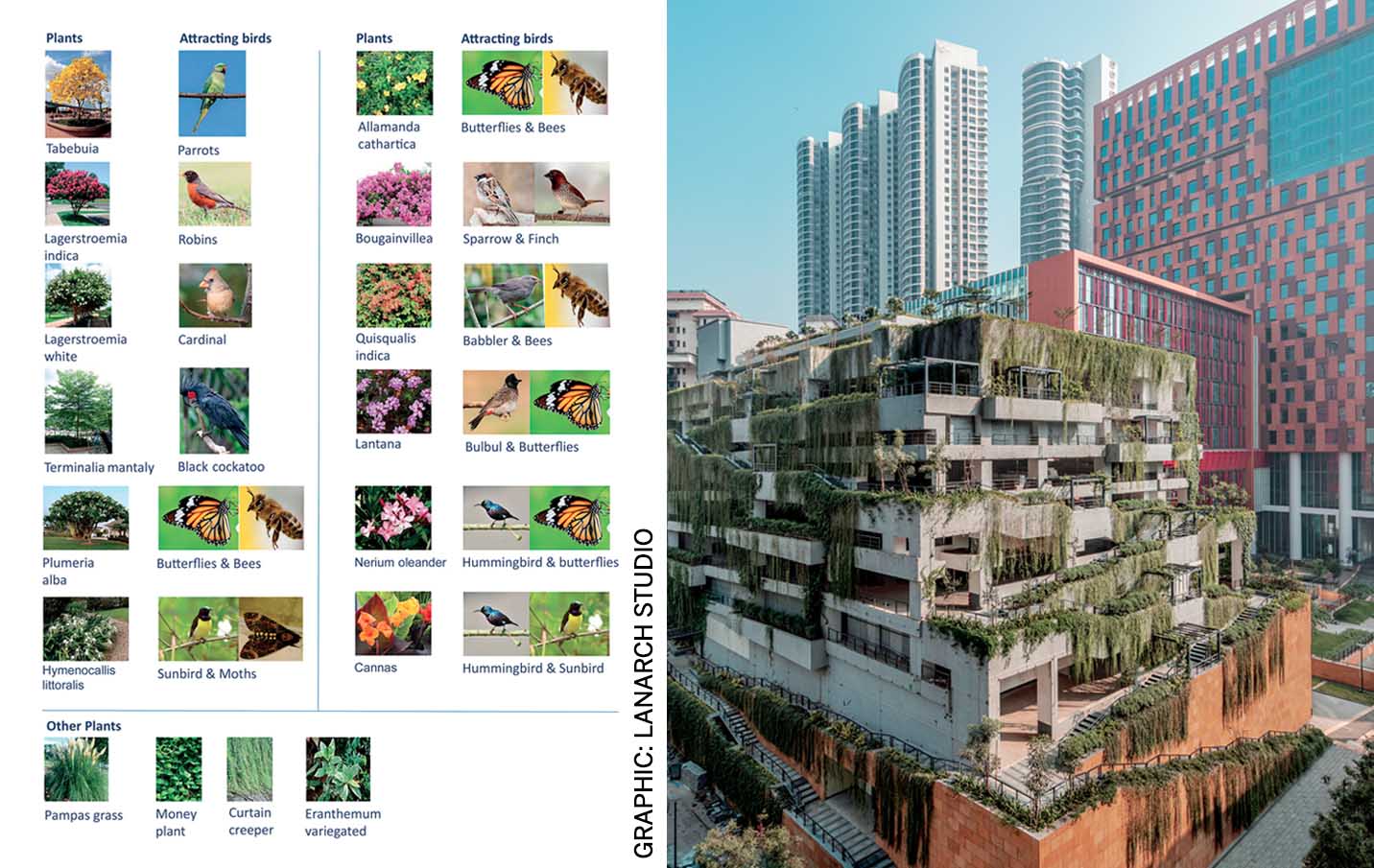
Flora and Fauna : plants and shrubs used and their attraction to birds and butterflies
Right: Photo on this page and the following pages show the effect of landscaping less than a year after planting. Trees and greenery will grow markedly in the coming years
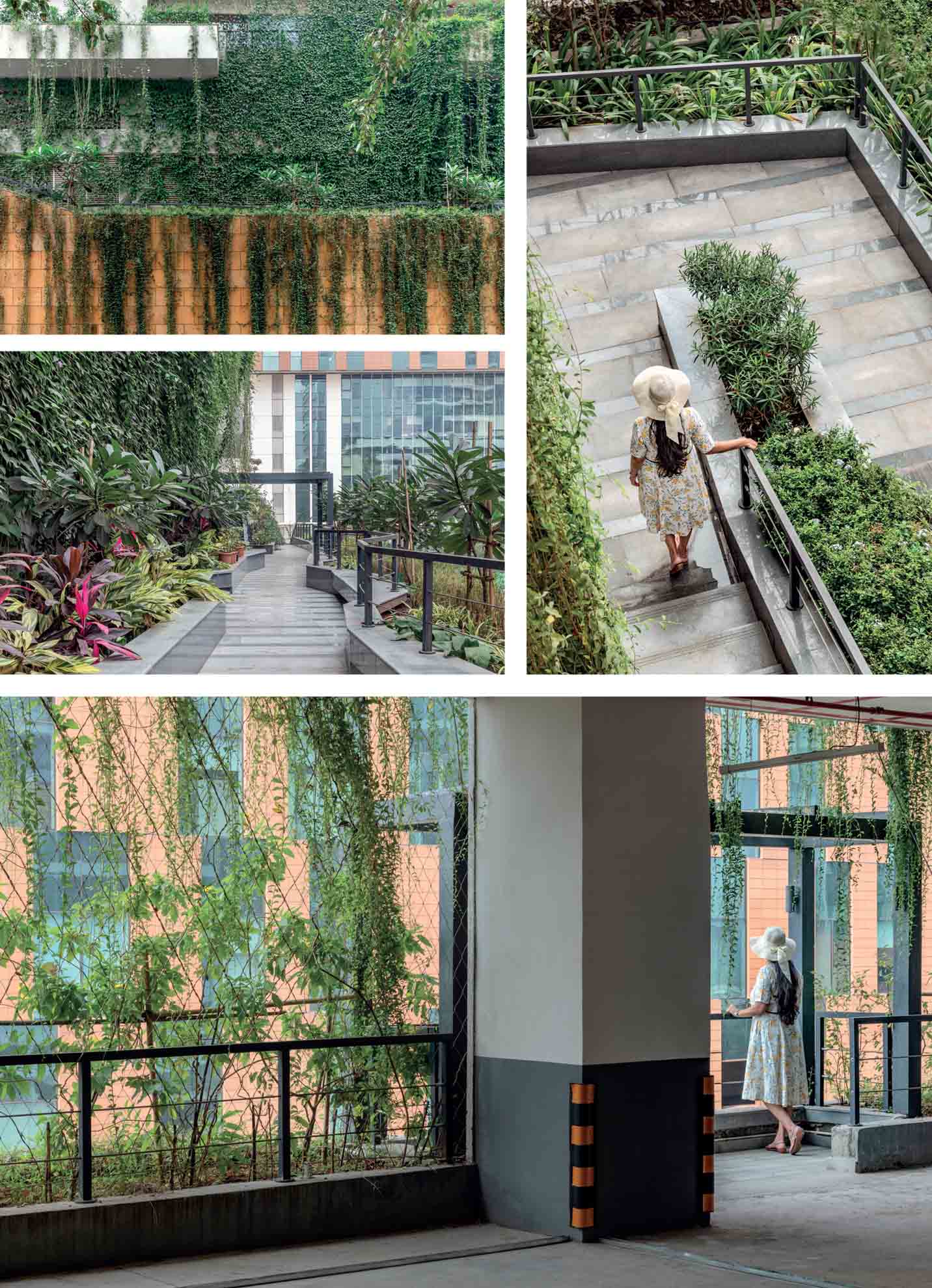
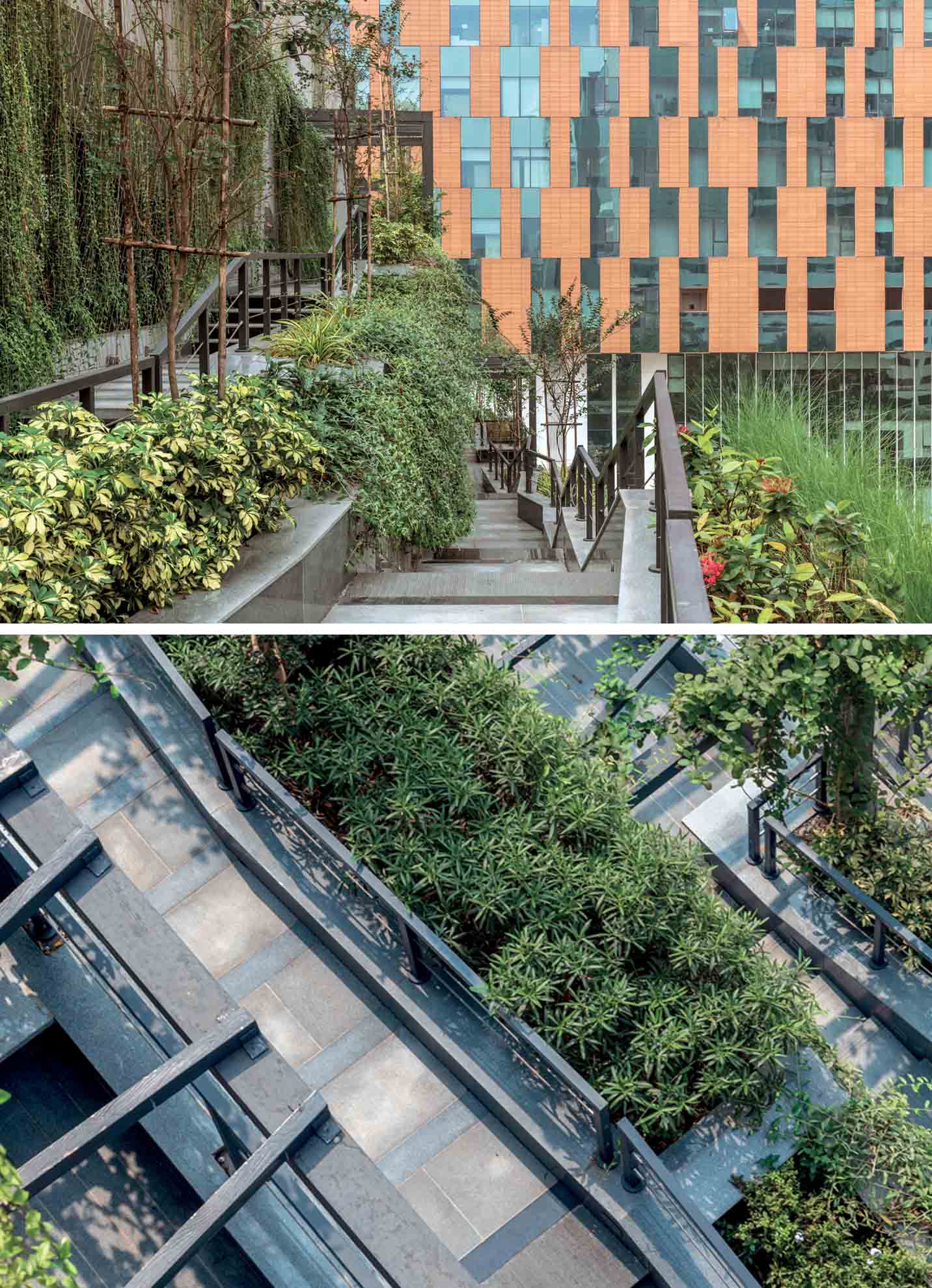
Birds and Bees
The Rock is a unique urban structure which, as the landscape grows on it, will provide a place for birds and bees, insects and butterflies. The choice of plantation will stimulate this.
As landscape architect Subhagya Atale puts it, “The use of varied plants in design will also impart ecological benefits to the project. By evolving the planting strategy further, a mutualistic relationship between plants, birds and insects could be developed over a period of time. While food-bearing trees will invite birds, flower-bearing plants will attract butterflies, bees and insects. In turn, these will help plants in pollination, keeping them healthy and free from parasites. Parrots can forage on Tabebuia flowers for nectar. Hummingbirds, Sunbirds and other birds can get nectar from plants like Nerium, Cannas and Lily. Some birds also feed on insects, ants and wasps around the plants and keep them healthy and free from parasites. Birds and bees that are key pollinators are attracted to flowers due to their colours. These transfer pollen grains between blooms, enabling plants to reproduce. Flower fragrance also attracts butterflies, bees and moths at different times of the day. Plumeria Alba, fragrant at night, attracts moths for pollination. Sparrows and Finch are attracted to the insects, which feed on the Bougainvillea plants.”
The process of The Rock’s conceptualisation, design and construction shows that, at moments of difficulty, a creative out-of-the-box solution can provide not only a way out of the dilemma but can lead to an original solution, in this case simultaneously solving an issue of infrastructure as well as enriching the urban ecology and landscape.
Worth mentioning in this matter is the teamwork between the various specialists involved in detailing my design concept by the architectural engineers VA Group and the landscape architect Lanarch Studio. And last, but not least, the willingness of an enlightened client: Nirlon Knowledge Park to undertake this complex project.
All photos : Courtesy Nirlon Knowledge Park

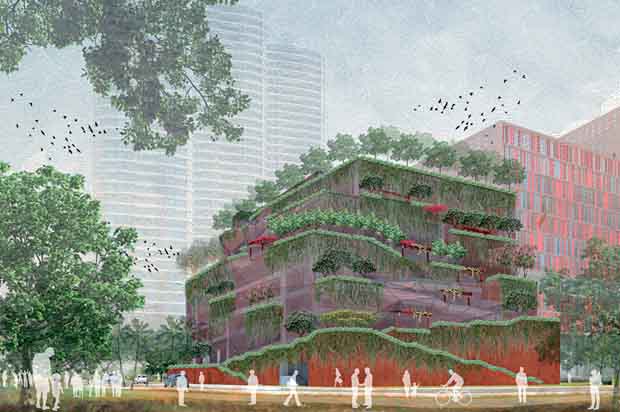

Comments (0)